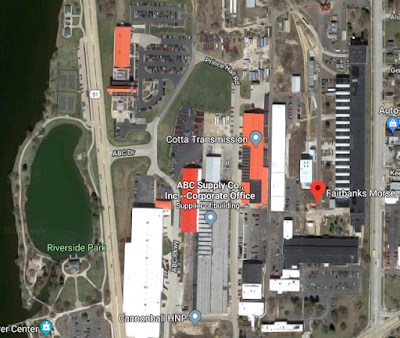Notes on the locomotives that they built are in a separate post. They have been making gensets for decades.
 |
| David Daruszka commented on a post Beloit was the location of locomotive factory. |
.jpg) |
| Lake States Railway Historical Association posted From the FM collection plant view of nose and cab assembly line in Beloit, WI--no date. If you enjoy the photos and what Lake States is accomplishing, consider joining Lake States or making a donation, or both, https://www.lsrha.org/?page_id=135. Ned Carlson: Building C-Liners Lake States Railway Historical Association shared |
 |
| Satellite |
 |
| Street View |
Steve Nichols For the past few years, they’ve been “busy” building engines for the US Navy’s Littoral Combat Ship program.
Nothing comes inbound via rail. Outbound engine loads have picked up since gaining this recent Navy order, but it is still rare and inconsistent. Maybe a heavy duty car every few months.
David Jordan I shot this Union Pacific MPRNL at Sullivan, Ilinois April 20, 2019. The 53rd car was shipped from F-M.
https://youtu.be/KnW-XdrURQQ
As Steve said, their primary business is with the US Navy. Not only do many US Navy ships have F-M Diesels as their primary power, they are also used as backup power on Nuclear Subs & Nuclear powered aircraft carriers.
Dennis DeBruler The Northern Illinois poster must have lost track of where he was along the Rock River because FM is in Beloit, WI, not Rockford.
https://www.google.com/.../data=!3m1!1e3!4m5!3m4...
I noticed that C&NW abandoned their route north of Beloit and UP abandoned the C&NW route south of Beloit, but UP owns the Milwaukee route east of town between their C&NW route through Clinton, WI and Beloit.
 |
| Dennis DeBruler commented on David's comment |
 |
| FM-about-us [Judging by the access hatches, this is an opposed piston engine.] |
 |
FM-productsFM | TRIDENT OP®
Engineered to endure, the Trident OP is the next-generation engine that answers the need for higher-efficiency power in a wide range of applications.
[I remember previously seeing an ALCO engine on the products page. I don't see ALCO in 2020. Perhaps they didn't bother to redesign it for Tier 4 emissions.] |
If you get bored watching, skip to near the end because it is interesting how long it takes the flywheels to slow down to a stop. Given that it is about a second between "pops," it does need a lot of flywheel inertia. (source)
 |
| Screenshot |
 |
| Screenshot @-0:30 When the Fairbanks Morse Company was first formed in 1823 it wasn’t gasoline engines it was building, but platform scales. The company got into the engine business in the late 1890s and became one of the most popular and successful gasoline engine and then diesel engine manufactures. This 15-25 (15 horsepower on the drawbar and 25 on the belt) was the company's first venture into traction engines and was designed around their 25 horsepower gasoline engine. By 1915 the company was out of the tractor business, but continued to sell tractors built by other manufactures under the Fair-Mor name. |
 |
| William Brown posted From the J Quinn Collection, Milwaukee Road Erie Built 22A leads a Commuter Train. No location, date or photographer on photo. The Erie Builds were named for where they were assembled Erie, PA by GE. The technology belonged to Fairbanks Morse, but GE built them. 22A was a 2000 HP locomotive built in September 1947 at a cost of $197,023/Unit. Used on the Olympian Hiawatha . In 1950 they were replaced by FP7s on the Olympian Hiawatha. In 1954 they were assigned to the Western Avenue Passenger Pool. They worked both Chicago Commuters and trains west through to Council Bluffs, Sioux City and Sioux Falls. The 22A was renumbered 14A. Retired in the first half of 1963 for Trade In to EMD on GP30s. This picture is from before the 1959 renumbering. Charles Berthold The motive power was from F-M in Beloit. |
I'm happy to report that Fairbanks-Morse is still making diesel engines. They power the largest
Laker on the Great Lakes.
 |
| Fairbanks Morse Engine posted We're honored to announce our latest contract with the United States Navy! Fairbanks Morse will be providing four sequentially turbocharged 16-cylinder Colt-Pielstick PC 2.5 diesel engines that will power LPD 29, a San Antonio-class ship. Read our press release to learn more: http://bit.ly/2CP8KkD Mitch Williams Had the 38f 5 1/4 on the Nashville. Good engine but could never put an keep a good load on it. Rings never seated and it slung oil on start-up Shaun Higley There was Fairbanks Morse engines on the John F. Kennedy |
 |
| Photo: GRANT HINDSLEY, SEATTLEPI.COM (source) |
 |
| safe_image for The History of Fairbanks Morse Engine YouTube Video |
 |
| Adam Bibeau posted Giving the diesel some recognition! Old decommissioned 1929 Fairbanks Morse. Augusta, Kansas Greg A. Adams: Looks like an early LS Cooper Bessemer just out of frame. Can tell it’s an early one by the BF-44 Elliott turbo. Cooper later developed their own (ET-18) turbo for their larger engines. David Geoff Morton: Worked DLA and OP Fairbanks. That one is old. |
 |
| 1 of 22 photos posted by David Schauer via Dennis DeBruler Power for the Barker is provided by two 8,000 bhp V-16 cylinder, four stroke cycle, single acting, turbocharged Colt-Pielstick PC2V diesel engines, built by Fairbanks Morse Engine Division of Colt Industries, Beloit, WI. The comment on the last photo: "M/V James R. Barker was the first 1000-foot class vessel constructed entirely on the Great Lakes, where she was built by American Ship Building Company at Lorain, Ohio. The James R. Barker is named for Interlake’s Chairman of the Board and has always been part of the Interlake Steamship fleet." |



























































%20HISTORICAL%20STRIPPING%20SHOVEL%20&%20DRAGLINE%20ARCHIVE%20_%20Bear%20Run%20maintenance%20_%20Fa.png)
